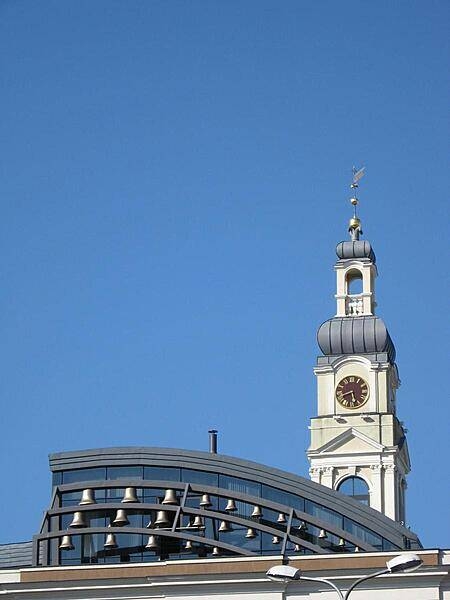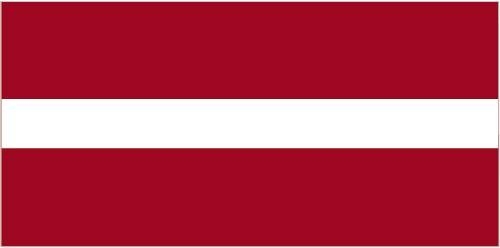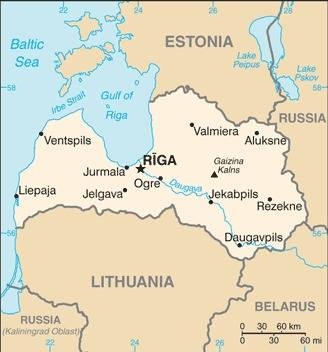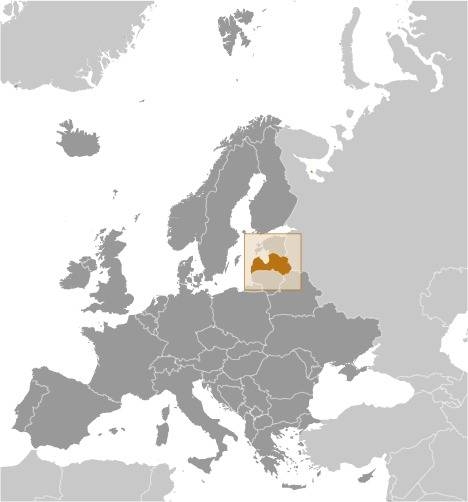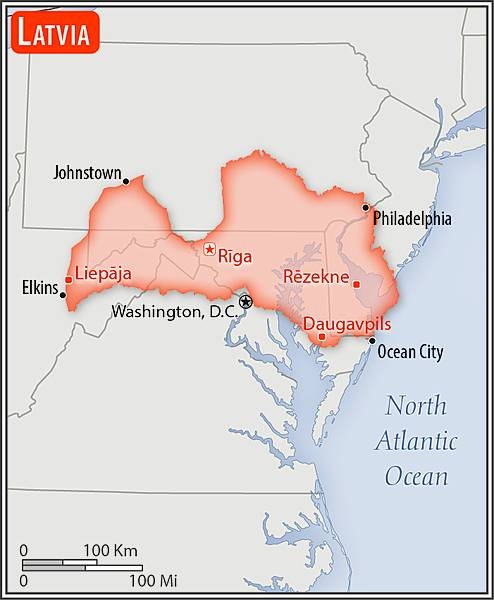Introduction
Background
Several eastern Baltic tribes merged in medieval times to form the ethnic core of the Latvian people (ca. 8th-12th centuries A.D.). The region subsequently came under the control of Germans, Poles, Swedes, and finally, Russians. A Latvian republic emerged following World War I, but it was annexed by the USSR in 1940 - an action never recognized by the US and many other countries. Latvia reestablished its independence in 1991 following the breakup of the Soviet Union. Although the last Russian troops left in 1994, the status of the Russian minority (some 25% of the population) remains of concern to Moscow. Latvia acceded to both NATO and the EU in the spring of 2004; it joined the euro zone in 2014 and the OECD in 2016. A dual citizenship law was adopted in 2013, easing naturalization for non-citizen children.
Visit the Definitions and Notes page to view a description of each topic.
Geography
Location
Eastern Europe, bordering the Baltic Sea, between Estonia and Lithuania
Geographic coordinates
57 00 N, 25 00 E
Map references
Europe
Land boundaries
total: 1,370 km
border countries (4): Belarus 161 km; Estonia 333 km; Lithuania 544 km; Russia 332 km
Coastline
498 km
Maritime claims
territorial sea: 12 nm
exclusive economic zone: limits as agreed to by Estonia, Finland, Latvia, Sweden, and Russia
continental shelf: 200 m depth or to the depth of exploitation
Climate
maritime; wet, moderate winters
Terrain
low plain
Elevation
highest point: Gaizina Kalns 312 m
lowest point: Baltic Sea 0 m
mean elevation: 87 m
Natural resources
peat, limestone, dolomite, amber, hydropower, timber, arable land
Land use
agricultural land: 29.2% (2018 est.)
arable land: 18.6% (2018 est.)
permanent crops: 0.1% (2018 est.)
permanent pasture: 10.5% (2018 est.)
forest: 54.1% (2018 est.)
other: 16.7% (2018 est.)
Irrigated land
6 sq km (2016)
note: land in Latvia is often too wet and in need of drainage not irrigation; approximately 16,000 sq km or 85% of agricultural land has been improved by drainage
Population distribution
largest concentration of people is found in and around the port and capital city of Riga; small agglomerations are scattered throughout the country
Natural hazards
large percentage of agricultural fields can become waterlogged and require drainage
Geography - note
most of the country is composed of fertile low-lying plains with some hills in the east
People and Society
Nationality
noun: Latvian(s)
adjective: Latvian
Ethnic groups
Latvian 62.7%, Russian 24.5%, Belarusian 3.1%, Ukrainian 2.2%, Polish 2%, Lithuanian 1.1%, other 1.8%, unspecified 2.6% (2021 est.)
Languages
Latvian (official) 56.3%, Russian 33.8%, other 0.6% (includes Polish, Ukrainian, and Belarusian), unspecified 9.4%; note - data represent language usually spoken at home (2011 est.)
major-language sample(s):
World Factbook, neaizstājams avots pamata informāciju. (Latvian)
The World Factbook, the indispensable source for basic information.
Religions
Lutheran 36.2%, Roman Catholic 19.5%, Orthodox 19.1%, other Christian 1.6%, other 0.1%, unspecified/none 23.5% (2017 est.)
Age structure
0-14 years: 15.32% (male 148,120/female 140,028)
15-24 years: 9% (male 87,372/female 81,965)
25-54 years: 40.41% (male 380,817/female 379,359)
55-64 years: 14.77% (male 125,401/female 152,548)
65 years and over: 20.5% (male 128,151/female 257,471) (2020 est.)
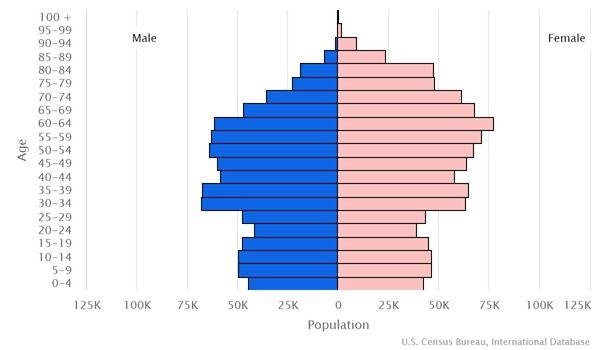
Dependency ratios
total dependency ratio: 59.3
youth dependency ratio: 24.9
elderly dependency ratio: 34.4
potential support ratio: 2.9 (2021 est.)
Median age
total: 44.4 years
male: 40.5 years
female: 48 years (2020 est.)
Population distribution
largest concentration of people is found in and around the port and capital city of Riga; small agglomerations are scattered throughout the country
Urbanization
urban population: 68.7% of total population (2023)
rate of urbanization: -0.68% annual rate of change (2020-25 est.)
Major urban areas - population
621,000 RIGA (capital) (2023)
Sex ratio
at birth: 1.05 male(s)/female
0-14 years: 1.06 male(s)/female
15-24 years: 1.06 male(s)/female
25-54 years: 1.02 male(s)/female
55-64 years: 0.84 male(s)/female
65 years and over: 0.36 male(s)/female
total population: 0.86 male(s)/female (2022 est.)
Mother's mean age at first birth
27.3 years (2020 est.)
Maternal mortality ratio
19 deaths/100,000 live births (2017 est.)
country comparison to the world: 124Infant mortality rate
total: 4.85 deaths/1,000 live births
male: 5.27 deaths/1,000 live births
female: 4.42 deaths/1,000 live births (2022 est.)
Life expectancy at birth
total population: 75.91 years
male: 71.47 years
female: 80.56 years (2022 est.)
Drinking water source
improved: urban: 99.9% of population
rural: 98.6% of population
total: 99.5% of population
unimproved: urban: 0.1% of population
rural: 1.4% of population
total: 0.5% of population (2020 est.)
Current health expenditure
6.6% of GDP (2019)
Physicians density
3.4 physicians/1,000 population (2020)
Hospital bed density
5.5 beds/1,000 population (2018)
Sanitation facility access
improved: urban: 98.9% of population
rural: 85.3% of population
total: 94.6% of population
unimproved: urban: 1.1% of population
rural: 14.7% of population
total: 5.4% of population (2020 est.)
Major infectious diseases
degree of risk: intermediate (2020)
vectorborne diseases: tickborne encephalitis
Alcohol consumption per capita
total: 12.9 liters of pure alcohol (2019 est.)
beer: 4.9 liters of pure alcohol (2019 est.)
wine: 1.7 liters of pure alcohol (2019 est.)
spirits: 5.3 liters of pure alcohol (2019 est.)
other alcohols: 1 liters of pure alcohol (2019 est.)
Tobacco use
total: 37% (2020 est.)
male: 50.3% (2020 est.)
female: 23.7% (2020 est.)
Literacy
definition: age 15 and over can read and write
total population: 99.9%
male: 99.9%
female: 99.9% (2018)
School life expectancy (primary to tertiary education)
total: 16 years
male: 16 years
female: 17 years (2020)
Youth unemployment rate (ages 15-24)
total: 14.8%
male: 14.9%
female: 14.6% (2021 est.)
Environment
Environment - current issues
while land, water, and air pollution are evident, Latvia's environment has benefited from a shift to service industries after the country regained independence; improvements have occurred in drinking water quality, sewage treatment, household and hazardous waste management, as well as reduction of air pollution; concerns include nature protection and the management of water resources and the protection of the Baltic Sea
Environment - international agreements
party to: Air Pollution, Air Pollution-Heavy Metals, Air Pollution-Multi-effect Protocol, Air Pollution-Persistent Organic Pollutants, Biodiversity, Climate Change, Climate Change-Kyoto Protocol, Climate Change-Paris Agreement, Comprehensive Nuclear Test Ban, Desertification, Endangered Species, Hazardous Wastes, Law of the Sea, Ozone Layer Protection, Ship Pollution, Tropical Timber 2006, Wetlands
signed, but not ratified: none of the selected agreements
Air pollutants
particulate matter emissions: 12.72 micrograms per cubic meter (2016 est.)
carbon dioxide emissions: 7 megatons (2016 est.)
methane emissions: 1.85 megatons (2020 est.)
Climate
maritime; wet, moderate winters
Land use
agricultural land: 29.2% (2018 est.)
arable land: 18.6% (2018 est.)
permanent crops: 0.1% (2018 est.)
permanent pasture: 10.5% (2018 est.)
forest: 54.1% (2018 est.)
other: 16.7% (2018 est.)
Urbanization
urban population: 68.7% of total population (2023)
rate of urbanization: -0.68% annual rate of change (2020-25 est.)
Revenue from forest resources
forest revenues: 0.85% of GDP (2018 est.)
country comparison to the world: 56Major infectious diseases
degree of risk: intermediate (2020)
vectorborne diseases: tickborne encephalitis
Waste and recycling
municipal solid waste generated annually: 857,000 tons (2015 est.)
municipal solid waste recycled annually: 181,941 tons (2015 est.)
percent of municipal solid waste recycled: 21.2% (2015 est.)
Total water withdrawal
municipal: 94.4 million cubic meters (2017 est.)
industrial: 25.2 million cubic meters (2017 est.)
agricultural: 61.5 million cubic meters (2017 est.)
Total renewable water resources
34.94 billion cubic meters (2017 est.)
Government
Country name
conventional long form: Republic of Latvia
conventional short form: Latvia
local long form: Latvijas Republika
local short form: Latvija
former: Latvian Soviet Socialist Republic (while occupied by the USSR)
etymology: the name "Latvia" originates from the ancient Latgalians, one of four eastern Baltic tribes that formed the ethnic core of the Latvian people (ca. 8th-12th centuries A.D.)
Government type
parliamentary republic
Capital
name: Riga
geographic coordinates: 56 57 N, 24 06 E
time difference: UTC+2 (7 hours ahead of Washington, DC, during Standard Time)
daylight saving time: +1hr, begins last Sunday in March; ends last Sunday in October
etymology: of the several theories explaining the name's origin, the one relating to the city's role in Baltic and North Sea commerce is the most probable; the name is likely related to the Latvian word "rija," meaning "warehouse," where the 'j' became a 'g' under the heavy German influence in the city from the late Middle Ages to the early 20th century
Administrative divisions
36 municipalities (novadi, singular - novads) and 7 state cities (valstpilsetu pasvaldibas, singular valstspilsetas pasvaldiba)
municipalities: Adazi, Aizkraukle, Aluksne, Augsdaugava, Balvi, Bauska, Cesis, Dienvidkurzeme, Dobele, Gulbene, Jekabpils, Jelgava, Kekava, Kraslava, Kuldiga, Limbazi, Livani, Ludza, Madona, Marupe, Ogre, Olaine, Preili, Rezekne, Ropazi, Salaspils, Saldus, Saulkrasti, Sigulda, Smiltene, Talsi, Tukums, Valka, Valmiera, Varaklani, Ventspils
cities: Daugavpils, Jelgava, Jurmala, Liepaja, Rezekne, Riga, Ventspils
Independence
18 November 1918 (from Soviet Russia); 4 May 1990 (declared from the Soviet Union); 6 September 1991 (recognized by the Soviet Union)
National holiday
Independence Day (Republic of Latvia Proclamation Day), 18 November (1918); note - 18 November 1918 was the date Latvia established its statehood and its concomitant independence from Soviet Russia; 4 May 1990 was the date it declared the restoration of Latvian statehood and its concomitant independence from the Soviet Union
Constitution
history: several previous (pre-1991 independence); note - following the restoration of independence in 1991, parts of the 1922 constitution were reintroduced 4 May 1990 and fully reintroduced 6 July 1993
amendments: proposed by two thirds of Parliament members or by petition of one tenth of qualified voters submitted through the president; passage requires at least two-thirds majority vote of Parliament in each of three readings; amendment of constitutional articles, including national sovereignty, language, the parliamentary electoral system, and constitutional amendment procedures, requires passage in a referendum by majority vote of at least one half of the electorate; amended several times, last in 2019
Legal system
civil law system with traces of socialist legal traditions and practices
International law organization participation
has not submitted an ICJ jurisdiction declaration; accepts ICCt jurisdiction
Citizenship
citizenship by birth: no
citizenship by descent only: at least one parent must be a citizen of Latvia
dual citizenship recognized: no
residency requirement for naturalization: 5 years
Suffrage
18 years of age; universal
Executive branch
chief of state: President Egils LEVITS (since 8 July 2019)
head of government: Prime Minister Krisjanis KARINS (since 23 January 2019)
cabinet: Cabinet of Ministers nominated by the prime minister, appointed by Parliament
elections/appointments: president indirectly elected by Parliament for a 4-year term (eligible for a second term); election last held on 29 May 2019 (next to be held in 2023); prime minister appointed by the president, confirmed by Parliament
election results: 2019: Egils LEVITS elected president; Parliament vote - Egils LEVITS 61 votes, Didzis SMITS 24 votes, Juris JANSONS 8 votes; Krisjanis KARINS confirmed prime minister 61-39
2015: Raimonds VEJONIS elected president; Raimonds VEJOONIS 55 votes, Egils LEVITS 42 votes
Legislative branch
description: unicameral Parliament or Saeima (100 seats; members directly elected in multi-seat constituencies by party-list proportional representation vote; members serve 4-year terms)
elections: last held on 6 October 2018 (next to be held in October 2022)
election results: percent of vote by party - S 19.8%, KPV LV 14.3%, JKP 13.6%, AP! 12%, NA 11%, ZZS 9.9%, JV 6.7%, other 12.7%; seats by party - S 23, KPV LV 16, JKP 16, AP! 13, NA 13, ZZS 11, JV 8; composition as of April 2022 - men 73, women 27, percent of women 27%
Judicial branch
highest court(s): Supreme Court (consists of the Senate with 36 judges); Constitutional Court (consists of 7 judges)
judge selection and term of office: Supreme Court judges nominated by chief justice and confirmed by the Saeima; judges serve until age 70, but term can be extended 2 years; Constitutional Court judges - 3 nominated by Saeima members, 2 by Cabinet ministers, and 2 by plenum of Supreme Court; all judges confirmed by Saeima majority vote; Constitutional Court president and vice president serve in their positions for 3 years; all judges serve 10-year terms; mandatory retirement at age 70
subordinate courts: district (city) and regional courts
Political parties and leaders
Development/For! or AP! [Daniels PAVLUTS, Juris PUCE]
For a Humane Latvia or PCL [Maris MOZVILLO] (formerly known as Who Owns the State?)
National Alliance "All For Latvia!"-"For Fatherland and Freedom/LNNK" or NA [Raivis DZINTARS]
New Unity or JV [Arturs Krišjānis KARINS]
Social Democratic Party "Harmony" or S [Janis URBANOVICS]
The Conservatives or K [Janis BORDANS] (formerly known as New Conservative Party or JKP)
Union of Greens and Farmers or ZZS [Aivars LEMBERGS]
United List or AS [Uldis PILENS] (electoral coalition including the Latvian Green Party or LZP, Latvian Association of Regions or LRA, Liepaja Party)
International organization participation
Australia Group, BA, BIS, CBSS, CD, CE, EAPC, EBRD, ECB, EIB, EMU, ESA (cooperating state), EU, FAO, IAEA, IBRD, ICAO, ICC (NGOs), ICCt, ICRM, IDA, IFC, IFRCS, IHO, ILO, IMF, IMO, IMSO, Interpol, IOC, IOM, IPU, ISO (correspondent), ITU, ITUC (NGOs), MIGA, NATO, NIB, NSG, OAS (observer), OIF (observer), OPCW, OSCE, PCA, Schengen Convention, UN, UNCTAD, UNESCO, UNHCR, UNWTO, UPU, Wassenaar Arrangement, WCO, WHO, WIPO, WMO, WTO
Diplomatic representation in the US
chief of mission: Ambassador Maris SELGA (since 16 September 2019)
chancery: 2306 Massachusetts Avenue NW, Washington, DC 20008
telephone: [1] (202) 328-2840
FAX: [1] (202) 328-2860
email address and website:
embassy.usa@mfa.gov.lv
https://www2.mfa.gov.lv/en/usa
Diplomatic representation from the US
chief of mission: Ambassador John Leslie CARWILE (since 5 November 2019)
embassy: 1 Samnera Velsa Street (former Remtes), Riga LV-1510
mailing address: 4520 Riga Place, Washington DC 20521-4520
telephone: [371] 6710-7000
FAX: [371] 6710-7050
email address and website:
askconsular-riga@state.gov
https://lv.usembassy.gov/
Flag description
three horizontal bands of maroon (top), white (half-width), and maroon; the flag is one of the older banners in the world; a medieval chronicle mentions a red standard with a white stripe being used by Latvian tribes in about 1280
National symbol(s)
white wagtail (bird); national colors: maroon, white
National anthem
name: "Dievs, sveti Latviju!" (God Bless Latvia)
lyrics/music: Karlis BAUMANIS
note: adopted 1920, restored 1990; first performed in 1873 while Latvia was a part of Russia; banned during the Soviet occupation from 1940 to 1990
National heritage
total World Heritage Sites: 2 (both cultural)
selected World Heritage Site locales: Historic Center of Riga; Struve Geodetic Arc
Economy
Economic overview
Latvia is a small, open economy with exports contributing more than half of GDP. Due to its geographical location, transit services are highly-developed, along with timber and wood-processing, agriculture and food products, and manufacturing of machinery and electronics industries. Corruption continues to be an impediment to attracting foreign direct investment and Latvia's low birth rate and decreasing population are major challenges to its long-term economic vitality.
Latvia's economy experienced GDP growth of more than 10% per year during 2006-07, but entered a severe recession in 2008 as a result of an unsustainable current account deficit and large debt exposure amid the slowing world economy. Triggered by the collapse of the second largest bank, GDP plunged by more than 14% in 2009 and, despite strong growth since 2011, the economy took until 2017 return to pre-crisis levels in real terms. Strong investment and consumption, the latter stoked by rising wages, helped the economy grow by more than 4% in 2017, while inflation rose to 3%. Continued gains in competitiveness and investment will be key to maintaining economic growth, especially in light of unfavorable demographic trends, including the emigration of skilled workers, and one of the highest levels of income inequality in the EU.
In the wake of the 2008-09 crisis, the IMF, EU, and other international donors provided substantial financial assistance to Latvia as part of an agreement to defend the currency's peg to the euro in exchange for the government's commitment to stringent austerity measures. The IMF/EU program successfully concluded in December 2011, although, the austerity measures imposed large social costs. The majority of companies, banks, and real estate have been privatized, although the state still holds sizable stakes in a few large enterprises, including 80% ownership of the Latvian national airline. Latvia officially joined the World Trade Organization in February 1999 and the EU in May 2004. Latvia also joined the euro zone in 2014 and the OECD in 2016.
Real GDP (purchasing power parity)
$56.92 billion (2020 est.)
$59.06 billion (2019 est.)
$57.88 billion (2018 est.)
note: data are in 2017 dollars
Real GDP growth rate
2.08% (2019 est.)
4.2% (2018 est.)
3.23% (2017 est.)
Real GDP per capita
$29,900 (2020 est.)
$30,900 (2019 est.)
$30,000 (2018 est.)
note: data are in 2017 dollars
GDP (official exchange rate)
$34.084 billion (2019 est.)
Inflation rate (consumer prices)
2.8% (2019 est.)
2.5% (2018 est.)
2.9% (2017 est.)
Credit ratings
Fitch rating: A- (2014)
Moody's rating: A3 (2015)
Standard & Poors rating: A+ (2020)
note: The year refers to the year in which the current credit rating was first obtained.
GDP - composition, by sector of origin
agriculture: 3.9% (2017 est.)
industry: 22.4% (2017 est.)
services: 73.7% (2017 est.)
GDP - composition, by end use
household consumption: 61.8% (2017 est.)
government consumption: 18.2% (2017 est.)
investment in fixed capital: 19.9% (2017 est.)
investment in inventories: 1.5% (2017 est.)
exports of goods and services: 60.6% (2017 est.)
imports of goods and services: -61.9% (2017 est.)
Agricultural products
wheat, milk, rapeseed, barley, oats, potatoes, rye, beans, pork, poultry
Industries
processed foods, processed wood products, textiles, processed metals, pharmaceuticals, railroad cars, synthetic fibers, electronics
Labor force - by occupation
agriculture: 7.7%
industry: 24.1%
services: 68.1% (2016 est.)
Youth unemployment rate (ages 15-24)
total: 14.8%
male: 14.9%
female: 14.6% (2021 est.)
Population below poverty line
22.9% (2018 est.)
Gini Index coefficient - distribution of family income
35.6 (2017 est.)
35.4 (2014)
Household income or consumption by percentage share
lowest 10%: 2.2%
highest 10%: 26.3% (2015)
Budget
revenues: 11.39 billion (2017 est.)
expenditures: 11.53 billion (2017 est.)
Public debt
36.3% of GDP (2017 est.)
37.4% of GDP (2016 est.)
note: data cover general government debt, and includes debt instruments issued (or owned) by government entities, including sub-sectors of central government, state government, local government, and social security funds
Fiscal year
calendar year
Current account balance
-$222 million (2019 est.)
-$99 million (2018 est.)
Exports
$20.23 billion (2020 est.) note: data are in current year dollars
$20.5 billion (2019 est.) note: data are in current year dollars
$21.12 billion (2018 est.) note: data are in current year dollars
Exports - partners
Lithuania 16%, Estonia 10%, Russia 9%, Germany 7%, Sweden 6%, United Kingdom 6% (2019)
Exports - commodities
lumber, broadcasting equipment, whiskey and other hard liquors, wheat, packaged medicines (2019)
Imports
$19.84 billion (2020 est.) note: data are in current year dollars
$20.79 billion (2019 est.) note: data are in current year dollars
$21.38 billion (2018 est.) note: data are in current year dollars
Imports - partners
Russia 21%, Lithuania 14%, Germany 9%, Poland 7%, Estonia 7% (2019)
Imports - commodities
refined petroleum, broadcasting equipment, cars, packaged medicines, aircraft (2019)
Reserves of foreign exchange and gold
$4.614 billion (31 December 2017 est.)
$3.514 billion (31 December 2016 est.)
Debt - external
$40.164 billion (2019 est.)
$42.488 billion (2018 est.)
Exchange rates
euros (EUR) per US dollar -
0.82771 (2020 est.)
0.90338 (2019 est.)
0.87789 (2018 est.)
0.885 (2014 est.)
0.7634 (2013 est.)
Energy
Electricity access
electrification - total population: 100% (2020)
Electricity
installed generating capacity: 3.089 million kW (2020 est.)
consumption: 6.706 billion kWh (2020 est.)
exports: 2.548 billion kWh (2020 est.)
imports: 4.173 billion kWh (2020 est.)
transmission/distribution losses: 377 million kWh (2020 est.)
Electricity generation sources
fossil fuels: 33.4% of total installed capacity (2020 est.)
nuclear: 0% of total installed capacity (2020 est.)
solar: 0.1% of total installed capacity (2020 est.)
wind: 3.2% of total installed capacity (2020 est.)
hydroelectricity: 47.5% of total installed capacity (2020 est.)
tide and wave: 0% of total installed capacity (2020 est.)
geothermal: 0% of total installed capacity (2020 est.)
biomass and waste: 15.9% of total installed capacity (2020 est.)
Coal
production: 0 metric tons (2020 est.)
consumption: 39,000 metric tons (2020 est.)
exports: 3,000 metric tons (2020 est.)
imports: 40,000 metric tons (2020 est.)
proven reserves: 0 metric tons (2019 est.)
Petroleum
total petroleum production: 1,600 bbl/day (2021 est.)
refined petroleum consumption: 39,900 bbl/day (2019 est.)
crude oil and lease condensate exports: 0 bbl/day (2018 est.)
crude oil and lease condensate imports: 0 bbl/day (2018 est.)
crude oil estimated reserves: 0 barrels (2021 est.)
Natural gas
production: 0 cubic meters (2021 est.)
consumption: 1,067,798,000 cubic meters (2020 est.)
exports: 0 cubic meters (2021 est.)
imports: 1,067,798,000 cubic meters (2020 est.)
proven reserves: 0 cubic meters (2021 est.)
Carbon dioxide emissions
8.45 million metric tonnes of CO2 (2019 est.)
from coal and metallurgical coke: 149,000 metric tonnes of CO2 (2019 est.)
from petroleum and other liquids: 5.693 million metric tonnes of CO2 (2019 est.)
from consumed natural gas: 2.608 million metric tonnes of CO2 (2019 est.)
Energy consumption per capita
86.645 million Btu/person (2019 est.)
country comparison to the world: 66Communications
Telephones - fixed lines
total subscriptions: 211,849 (2020 est.)
subscriptions per 100 inhabitants: 11 (2020 est.)
Telephones - mobile cellular
total subscriptions: 2,051,359 (2020 est.)
subscriptions per 100 inhabitants: 109 (2020 est.)
Telecommunication systems
general assessment: the telecom market continues to benefit from investment and from regulatory measures aimed at developing 5G and fiber based infrastructure; there is effective competition in the mobile market, with extensive services based on LTE-A technologies to boost data speeds; a large scale 5G deployment is not expected until 2023; in the fixed-line broadband sector, the country is ranked second highest in Europe (after Iceland) for fiber coverage and take-up, closely followed by Lithuania; with this infrastructure in place, the country has also developed a sophisticated digital economy, with e-commerce and e-government services widely available (2021)
domestic: fixed-line roughly 11 per 100 and mobile-cellular nearly 109 per 100 subscriptions (2020)
international: country code - 371; the Latvian network is now connected via fiber-optic cable to Estonia, Finland, and Sweden
note: the COVID-19 pandemic continues to have a significant impact on production and supply chains globally; since 2020, some aspects of the telecom sector have experienced a downturn, particularly in mobile device production; progress toward 5G implementation has resumed, as well as upgrades to infrastructure; consumer spending on telecom services has increased due to the surge in demand for capacity and bandwidth; the crucial nature of telecom services as a tool for work and school from home is still evident, and the spike in this area has seen growth opportunities for development of new tools and increased services
Broadcast media
several national and regional commercial TV stations are foreign-owned, 2 national TV stations are publicly owned; system supplemented by privately owned regional and local TV stations; cable and satellite multi-channel TV services with domestic and foreign broadcasts available; publicly owned broadcaster operates 4 radio networks with dozens of stations throughout the country; dozens of private broadcasters also operate radio stations
Internet users
total: 1,663,739 (July 2022 est.)
percent of population: 89.8% (July 2022 est.)
Broadband - fixed subscriptions
total: 490,569 (2020 est.)
subscriptions per 100 inhabitants: 26 (2020 est.)
Transportation
National air transport system
number of registered air carriers: 3 (2020)
inventory of registered aircraft operated by air carriers: 53
annual passenger traffic on registered air carriers: 4,058,762 (2018)
annual freight traffic on registered air carriers: 4.01 million (2018) mt-km
Airports - with paved runways
total: 18
over 3,047 m: 1
2,438 to 3,047 m: 3
1,524 to 2,437 m: 4
914 to 1,523 m: 3
under 914 m: 7 (2021)
Airports - with unpaved runways
total: 24
under 914 m: 24 (2021)
Heliports
1 (2021)
Pipelines
1,213 km gas, 417 km refined products (2018)
Railways
total: 1,860 km (2018)
narrow gauge: 34 km (2018) 0.750-m gauge
broad gauge: 1,826 km (2018) 1.520-m gauge
Roadways
total: 70,244 km (2018)
paved: 15,158 km (2018)
unpaved: 55,086 km (2018)
Merchant marine
total: 70
by type: general cargo 22, oil tanker 9, other 39 (2021)
Ports and terminals
major seaport(s): Riga, Ventspils
Transportation - note
Latvia operates one PC 5 or 6 class icebreaker in the Baltic Sea
note - PC indicates a Polar Class vessel: PC 5 - year-round operation in medium first-year ice which may include old ice inclusions (ice thickness up to 70-120 cm); PC 6 - summer/autumn operation in medium first-year ice which may include old ice inclusions (ice thickness up to 30-70 cm)
Military and Security
Military and security forces
National Armed Forces (Nacionalie Brunotie Speki): Land Forces (Latvijas Sauszemes Speki), Naval Force (Latvijas Juras Speki, includes Coast Guard (Latvijas Kara Flote)), Air Force (Latvijas Gaisa Speki), National Guard (2022)
Military expenditures
2.1% of GDP (2022 est.)
2.2% of GDP (2021)
2.2% of GDP (2020)
2% of GDP (2019) (approximately $920 million)
2.1% of GDP (2018) (approximately $900 million)
Military and security service personnel strengths
approximately 7,500 active duty troops (6,500 Land Forces; 500 Naval Force/Coast Guard; 500 Air Force; note - some Land Forces are considered joint forces); 8,200 National Guard (2022)
Military equipment inventories and acquisitions
the Latvian military's inventory is limited and consists of a mixture of Soviet-era and more modern--mostly second-hand--European and US equipment; since 2010, it has received limited amounts of equipment from several European countries, Israel, and the US (2021)
Military service age and obligation
18 years of age for voluntary male and female military service; no conscription (abolished 2007) (2022)
note 1: in July 2022, the Latvian Government announced that it was reinstating mandatory military service for men aged 18-27 (women voluntarily) beginning in July 2023; service would be for one year in the Land Forces or alternatively in internal affairs, health, or welfare structures
note 2: as of 2019, women comprised about 16% of the military's full-time personnel
Military deployments
130 Kosovo (KFOR/NATO) (2022)
Military - note
Latvia became a member of NATO in 2004
since 2017, Latvia has hosted a Canadian-led multi-national NATO ground force battlegroup as part of the Alliance’s Enhanced Forward Presence initiative; in addition, Latvia hosts a NATO-led divisional headquarters (Multinational Division North; activated 2020), which coordinates training and preparation activities of its respective subordinate NATO battlegroups in Estonia and Latvia
NATO also has provided air protection for Latvia since 2004 through its Air Policing mission; NATO member countries that possess air combat capabilities voluntarily contribute to the mission on 4-month rotations (2022)
Transnational Issues
Disputes - international
Latvia-Belarus: Belarus and Latvia signed joint demarcation map in September 2008
Latvia-Estonia: demarcation reportedly completed in 1998
Latvia-Lithuania: boundary demarcation was completed by the end of 1998; the Latvian parliament has not ratified its 1998 maritime boundary treaty with Lithuania, primarily due to concerns over oil exploration rights
Latvia-Russia: Russia demands better Latvian treatment of ethnic Russians in Latvia; in March 2007, Latvia and Russia signed a border treaty, which includes Latvia withdrawing claims to a district now in Russia that was part of Latvia before WWII; the permanent demarcation of the boundary between Latvia and Russia was completed and came into force in April 2018; as a member state that forms part of the EU's external border, Latvia has implemented the strict Schengen border rules with Russia
Refugees and internally displaced persons
refugees (country of origin): 34,792 (Ukraine) (as of 20 December 2022)
stateless persons: 209,168 (mid-year 2021); note - individuals who were Latvian citizens prior to the 1940 Soviet occupation and their descendants were recognized as Latvian citizens when the country's independence was restored in 1991; citizens of the former Soviet Union residing in Latvia who have neither Latvian nor other citizenship are considered non-citizens (officially there is no statelessness in Latvia) and are entitled to non-citizen passports; children born after Latvian independence to stateless parents are entitled to Latvian citizenship upon their parents' request; non-citizens cannot vote or hold certain government jobs and are exempt from military service but can travel visa-free in the EU under the Schengen accord like Latvian citizens; non-citizens can obtain naturalization if they have been permanent residents of Latvia for at least five years, pass tests in Latvian language and history, and know the words of the Latvian national anthem
Illicit drugs
transshipment and destination point for cocaine, synthetic drugs, opiates, and cannabis from Southwest Asia, Western Europe, Latin America, and neighboring Baltic countries; despite improved legislation, vulnerable to money laundering due to nascent enforcement capabilities and comparatively weak regulation of offshore companies and the gaming industry; CIS organized crime (including counterfeiting, corruption, extortion, stolen cars, and prostitution) accounts for most laundered proceeds
